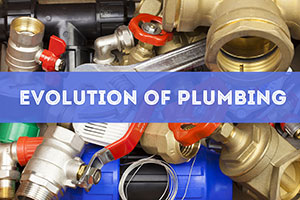Ever since ancient times there has been a need for plumbing. Excavating a deep well to extract water from an underground stream was one of the first examples. Water had to be transported in urns because pipework had not yet developed. The quest for providing growing towns with a convenient water supply began in earnest on the isle of Samos in 530 BC when Epaulinus, a Greek engineer constructed a tunnel with a length of 1.6km and a diameter of 2.4 metres to channel water from nearby mountains. In 300 BC the Egyptian city of Alexandria had a pumped, suction lift water supply that was primarily used for fire-fighting.
Roman Plumbing
By 300 BC the Roman inclination for comfort within the home led to even larger aqueducts being constructed. Water was supplied to individual homes in lead pipes although these were heavily taxed prompting the development of large public baths and rows of communal toilets that had channels for washing away waste. In the first century ruins of Pompeii, archaeologists have discovered hydraulic plumbing systems that used siphoned water to create fountains.
Mediaeval Pipework
A 4km mediaeval aqueduct known as the Great Conduit was constructed in London. It used lead pipes to transport the fresh water of a spring at Tyburn to Cheapside and the surrounding area. Magnificent buildings such as Warwick castle featured primitive garderobes or water closets that were little more than an outlet in the wall that let waste fall into the surrounding moat. Water pumps that could be operated by hand became popular for moving water vertically. They consisted of a revolving chain that extracted water as it passed through an underground stream then carried it upwards to flow through the pipe.
Tudor Royal Flush
The great breakthrough in sanitation occurred in 1596 when Sir John Harrington, a courtier to Elizabeth I, invented a flushing toilet for his manor house in the Somerset village of Kelston. It had a tank fitted with a valve that allowed a quantity of water to flood into the bowl below and drain away through a pipe.
Nineteenth Century Waterworks
Water supplies and sanitation became priorities for the UK as diseases such as cholera and typhoid became widespread. Extensive sewers were installed and new buildings were required by law to be connected to them. By 1828 water treatment had been introduced with a filtration system first in Paisley then Chelsea. Sand filters and chlorination were to be widely used to combat disease and bacteria. In 1860 boilers and stoves were used to provide hot water and through a series of coiled pipes formed central heating. Twenty years later radiators were being manufactured.
In 1870, Thomas Twyford developed the toilet further with his ceramic version that was constructed from a single unit and included a flush mechanism. The overhead chain pull mechanism was developed in 1880 followed a decade later by a distinctly modern flushing toilet. In the 1890s Joseph Chamberlain arranged for the city of Birmingham to receive a piped fresh water supply from the Elan Valley in Wales.
Modern Day Technology
Hygiene continued to be important with the invention in 1986 of a flushing toilet fitted with an infra red sensor rather than having to touch a handle to dispense the water. Today's plumbing industry is concerned with green energy and the conservation of resources to reduce the carbon footprint. Effective toilet flush mechanisms have reduced the three gallon flush by half. An improved energy level is at the forefront of environmentally-friendly boiler technology. Condensing boilers are rated as the most efficient with a 90% saving on fuel due to utilising heat that would otherwise leak into the air. Cost-effective combi boilers heat water taken from the main supply bypassing the need for a water tank and come with an A rated efficiency making them a popular choice. System boilers include integral pumps and are easy to maintain.

Add new comment